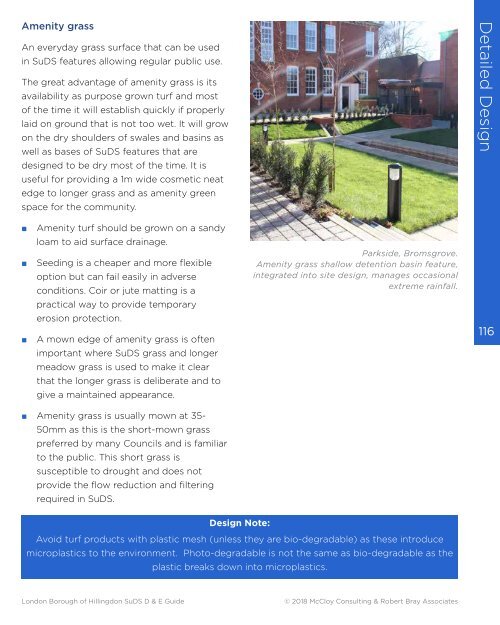Hillingdon SuDS Design & Evaluation Guide
You also want an ePaper? Increase the reach of your titles
YUMPU automatically turns print PDFs into web optimized ePapers that Google loves.
Amenity grass<br />
An everyday grass surface that can be used<br />
in <strong>SuDS</strong> features allowing regular public use.<br />
The great advantage of amenity grass is its<br />
availability as purpose grown turf and most<br />
of the time it will establish quickly if properly<br />
laid on ground that is not too wet. It will grow<br />
on the dry shoulders of swales and basins as<br />
well as bases of <strong>SuDS</strong> features that are<br />
designed to be dry most of the time. It is<br />
useful for providing a 1m wide cosmetic neat<br />
edge to longer grass and as amenity green<br />
space for the community.<br />
Detailed <strong>Design</strong><br />
■■<br />
■■<br />
■■<br />
Amenity turf should be grown on a sandy<br />
loam to aid surface drainage.<br />
Seeding is a cheaper and more flexible<br />
option but can fail easily in adverse<br />
conditions. Coir or jute matting is a<br />
practical way to provide temporary<br />
erosion protection.<br />
A mown edge of amenity grass is often<br />
important where <strong>SuDS</strong> grass and longer<br />
meadow grass is used to make it clear<br />
that the longer grass is deliberate and to<br />
give a maintained appearance.<br />
Parkside, Bromsgrove.<br />
Amenity grass shallow detention basin feature,<br />
integrated into site design, manages occasional<br />
extreme rainfall.<br />
116<br />
■■<br />
Amenity grass is usually mown at 35-<br />
50mm as this is the short-mown grass<br />
preferred by many Councils and is familiar<br />
to the public. This short grass is<br />
susceptible to drought and does not<br />
provide the flow reduction and filtering<br />
required in <strong>SuDS</strong>.<br />
<strong>Design</strong> Note:<br />
Avoid turf products with plastic mesh (unless they are bio-degradable) as these introduce<br />
microplastics to the environment. Photo-degradable is not the same as bio-degradable as the<br />
plastic breaks down into microplastics.<br />
London Borough of <strong>Hillingdon</strong> <strong>SuDS</strong> D & E <strong>Guide</strong><br />
© 2018 McCloy Consulting & Robert Bray Associates


